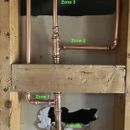Efficient hot water distribution system
I am repiping my house and realize that the plumber is not much help in designing an efficient hot water distribution system. My goal is to cut down water and time that is wasted when waiting for hot water to reach the fixtures. After the water heater i am branching into three separate zones that deliver hot water into three different areas of the house. The line out of the water heater is 3/4 and i am branching off 3 zones with a 1/2 pipe each (smaller pipe for higher velocity, I am not concern about pressure drop).
I have attached a picture of the piping directly after the water heater.
Question is. If Zone 3 calls for hot water and then Zone 1 calls for hot water will Zone 1 then take up all the hot water leaving Zone 3 with insufficient hot water?
Hope this question make sense.
Thank you!
GBA Detail Library
A collection of one thousand construction details organized by climate and house part










Replies
njansen,
No. If you open a hot water tap anywhere, that water comes from the tank. There is nowhere else for it to come from.
You won't have much issue with pressure drop with 1/2" pipe assuming only a small number of fixtures in each zone, or a particularly long run (and I doubt you'll have a run that long). You should be thinking about pressure drop though, especially for things like shower heads where it's more noticeable than with something like a sink.
Regarding your concern about one zone hogging all the hot water, that shouldn't be a problem. Flow rate to each respective fixture has to do with the "head" (restriction to flow) to each fixture, through the entire network of pipe all the way back to the source. You have a sort of manifold made with 3/4" pipe, which should keep pretty much even pressures to the start of each 1/2" pipe run, regardless of what any particular 1/2" pipe is doing. This means that it's only the restriction in those 1/2" lines that will affect the balance of flow rates to each fixture. Basically that means the pressure drop to any fixture isn't going to change much when another fixture turns on, aside from whatever pressure drop there may be at the source (the supply to the water heater), which you can't really control here.
In practice, I don't think you'll have any issue with any particular zone hogging hot water. You'd need to have *very* different piping between two fixtures to really even notice much in terms of pressure differences here. The only thing you're likely to notice is that when you have multiple fixtures using hot water, you're water heater will run out of supply sooner (which means less time with hot water for a tank-type hot water heater, or not-as-hot hot water for a tankless hot water heater).
BTW, be sure to insulate all those hot water pipes, which will help keep the water hotter for the fixtures, and will also help to get the hot water hot faster when you first turn those fixtures on.
Note that you can optimize a hot water system for either least wasted water (fastest "time to hot"), or least wasted energy (least input energy to heat up the water), but it's difficult to do both at the same time. For least wasted water, it's hard to a beat loop with a circulation pump or a thermosiphon, because either of those makes the effective length of pipe from the hot water supply only the short run between the circulating loop and each fixture, which tend to be short runs. The tradeoff with such a system is that that circulation loop acts like a radiator, so it uses more energy due to more standby losses in the system. The least wasted energy system is usually a trunk or manifold system, with the manifold system (seperate relatively small line to each fixture) tending to be the best balance of least energy waste to least water waste. If you're in an area with water shortages, I'd aim for least water waste and not worry about the slightly higher energy use, since water is the more valuable commodity in that case.
Edit: Malcolm made one point I didn't, at least not directly. The hot water to any fixture will always come from the hot water supply, so you'll never have "cold" water any fixture just because another fixture is turned on using hot water. The ONLY things that will come up are pressure changes (due to flow restriction I mentioned earlier), and the time to exhaust the supply of hot water (for a tank-type heater), or the "hotness" of hot water in the case of an on-demand water heater.
Bill
"Note that you can optimize a hot water system for either least wasted water (fastest "time to hot"), or least wasted energy (least input energy to heat up the water), but it's difficult to do both at the same time. "
This is very true. Note that traditionally plumbers have optimized for lowest installation time and cost, so there's probably quite a bit of room to find a happy medium between those two.
If you still have an opportunity to do so, consider a recirc system that is CONTROLLED - ie not one that constantly recirculates - that just wastes energy.
Also head over to the Energy Vanguard blog and read up on water line distribution.